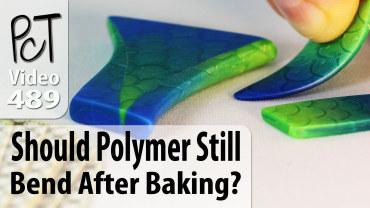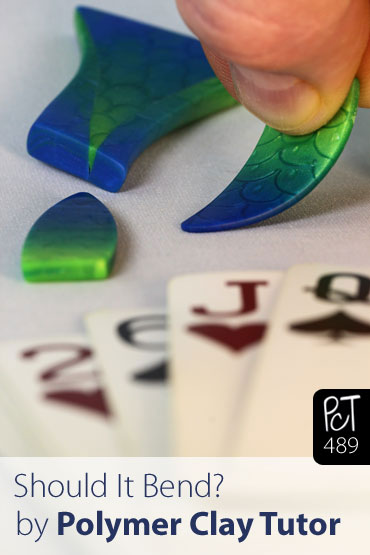Should Polymer Clay Still Bend After It’s Been Baked?
Video #489: It depends on the thickness, but yes, polymer clay does stay somewhat flexible.
More...
IN THIS POST: — flexible — baking — curing — bendy — bend — bendable — (Topics marked with an asterisk* are discussed in the Comments Section below).
Topics Covered In This Video:
- A very common beginner baking question.
- Is it normal for my polymer clay to still be bendy after baking?
- Help… did I do something wrong?
- Polymer clay is not like regular earthen clay that cures rock hard.
- Polymer clay, like Premo Sculpey for example, remain flexible when baked, especially when thin.
- In this video, I show samples of baked polymer clay at various thicknesses, and bend them to show how much flexibility you should expect.
- 2-3 playing cards thick = very flexible.
- 6-8 playing cards thick = slightly flexible.
- 14-16 playing cards thick = very stiff.
- Temperature can affect flexibility. Cool Temps = Stiffer. Warm Temps = More Flexible.
- Some coatings will affect stiffness, some won’t.
- Thin flexible coating like Aleene’s Jewelry Gel will not make the piece stiffer.
- Thick Resin coatings, like UV Resin Lisa Pavelka’s Magic Glos, will make the piece much stiffer.
- The short answer to “Should it Bend?” is “Yes. Depends on the thickness, how much it’ll bend.”
00:00:03 –> 00:00:07 Hi guys, its Cindy Lietz, your Polymer Clay Tutor, and in today’s Studio Tip, we’re
00:00:07 –> 00:00:12 talking about Polymer clay; should it bend after baking?
00:00:12 –> 00:00:19 Now, I get this panicked question from people quite often, and they bake their Polymer clay
00:00:19 –> 00:00:24 and it’s all bendy and they’re worried about it, did they do something wrong, and
00:00:24 –> 00:00:27 I’m going to show you that, no you haven’t.
00:00:27 –> 00:00:33 Now Polymer clay is not like regular earthen clay that bakes rock hard, if it’s properly
00:00:33 –> 00:00:41 baked, it’s actually going to stay quite flexible, and I’m using Premo Polymer clay,
00:00:41 –> 00:00:47 and it is quite a strong clay, but after baked, if it’s on the thin side, it’s going to
00:00:47 –> 00:00:48 be quite flexible.
00:00:48 –> 00:00:50 Now, there is…
00:00:50 –> 00:00:56 I’m gonna show you the different thicknesses and how flexible it will be after baking,
00:00:56 –> 00:01:02 now I’ve got some pieces here all from a tutorial I did in the past called Mermaid
00:01:02 –> 00:01:06 Scales, and it has quite a neat look, but I’ve got it in a variety of thicknesses
00:01:06 –> 00:01:07 here.
00:01:07 –> 00:01:12 This one…and I’m gonna use some playing cards to show the thickness of them, so this
00:01:12 –> 00:01:22 one here is about, let’s see, about 2 or 3 playing cards thick and you can see that
00:01:22 –> 00:01:24 it is quite flexible.
00:01:24 –> 00:01:31 Now, this one here is a little thicker, I would say it’s closer to…let’s see,
00:01:31 –> 00:01:50 maybe 6 or 8 thick…7 thick, and it is flexible still, but a lot stiffer.
00:01:50 –> 00:01:57 Now, you move on to this thicker piece here, and it is closer to about 14 I believe…something
00:01:57 –> 00:02:10 like that, or maybe even a more…yeah, it’s about 16 thick and it is really difficult
00:02:10 –> 00:02:17 to bend, and so, if you’re looking for… to make a pendant or something, and you want
00:02:17 –> 00:02:23 it to have a real stiff feel to it, you’re going to need to make it quite a bit thicker
00:02:23 –> 00:02:25 if you don’t want to move it all.
00:02:25 –> 00:02:30 And it also changes a little bit with temperature, so if this is in a really cold environment
00:02:30 –> 00:02:33 it’ll be stiffer, and if you’re in a really warm environment…or say it’s sitting on
00:02:33 –> 00:02:39 your neck or something, it will be more flexible as it warms up.
00:02:39 –> 00:02:44 Now some people believe that if you put a coating on it, it will make it stiff, and
00:02:44 –> 00:02:50 it can depending on the coating, now I’ve got a coating here, we tested this out the
00:02:50 –> 00:02:57 other day and this is the Aleene’s jewelry gel, and as you can see, it really didn’t
00:02:57 –> 00:02:59 stiffen up this piece at all.
00:02:59 –> 00:03:04 But, if you use something like a resin coating, now this is a UV resin, this happens to be
00:03:04 –> 00:03:13 Magic Gloss, and I’ve got two samples here of…this is from the new Polymer clay Batik
00:03:13 –> 00:03:20 Technique tutorial that I have, and these pieces are thicker, they’re around the10…about
00:03:20 –> 00:03:28 10 playing cards thick, this one here has a bit of flexibility to it, but with the UV
00:03:28 –> 00:03:35 resin on it, it’s really, really stiff, so you can take a thinner piece and put some
00:03:35 –> 00:03:39 resin on it to make it stiffer, but most of the other coatings aren’t going to make
00:03:39 –> 00:03:41 it stiffer at all.
00:03:41 –> 00:03:47 So, to answer your questions of some of you that are panicking out there…should it bend?
00:03:47 –> 00:03:53 Yes, especially if it’s thin, if it’s thicker, well it may not bend quite as much.
00:03:53 –> 00:03:57 So I hope that answers some questions for you, and I hope you liked this video, let
00:03:57 –> 00:03:59 me know if you did.
00:03:59 –> 00:04:04 And if you have any questions or comments that you would like to add, that would be
00:04:04 –> 00:04:05 great.
00:04:05 –> 00:04:09 Questions about some other products that you would like to have me test, or techniques,
00:04:09 –> 00:04:14 or tips, or tutorials, or any kind of thing you’d like me to do for you in another future
00:04:14 –> 00:04:17 video, do leave those in the comment section below.
00:04:17 –> 00:04:20 So we’ll see you next time and bye for now.
Our goal is to translate these videos into as many languages as possible. If you are interested in helping with this initiative, then please do contact us and we will figure out a way to make it worth your while :)
Resource Links:
- Related Video: Aleene’s Jewelry Pendant Gel
- Related Video: Using UV Epoxy Resin on Polymer Clay
- Related Video: Mermaid Scales Tutorial
Resources marked with a double ** asterisk are affiliate links. If you click on them and decide to buy something, we may receive some compensation. This does not affect the price you pay in any way. What it does do, however, is helps us to continue providing free videos for you, here at the PcT website. Using our links to purchase your tools and supplies, is always greatly appreciated.
Sponsored Ads & Special Promotions

Shareable Images



To share this full blog post anywhere on the web that allows links in comments, here's a shortened url to copy and paste...
>> https://mypct.ca/v489 <<

Want to chat about today’s post? That’s what the comment section below is for. Scroll Down… We’d love to hear from you!
Or... if you would like to request a topic for a future post, here is the link to do that… PcT Suggestion Box

I’ve made an ornament of my son’s handprint with craftsmart polymer clay and it’s still pretty soft. I’ve baked it for a half an hour, I popped it back in for an hour. Is it supposed to still be so bendy? Its about 1/4 in thick. I was going to paint it with acrylic paint, but it seems too flexible to me.
I didn’t know where to put a general question, so I chose here????.
After polymer clay is baked, is it safe to use for edible items to be displayed in, such as a polymer clay bowl with candy in it that doesn’t have a wrapping on it.
Hi Janice,
Everything I’ve read says do not use polymer clay for food dishes or utensils. The best explanation I’ve seen for this is that polymer clay cannot be properly cleaned to prevent bacterial growth – it is too porous. Makes sense to me as even a proper hand cleaning probably risks damaging the clay or leaving behind soap residue.
If you could find an insert that you can remove to clean, you could probably build a pretty polymer bowl around it. For example, try a simple clear glass bowl.
Hi Feree! Perhaps suspect conditioning issues if you are using brand name clays and proper baking. Maybe, it needs to be worked longer to “wake it up?” Looking at my old stuff that did not wear well (thank goodness I kept it, rofl), I suspect that I might have rushed that part, especially after watching the conditioning process with Premo, when Cindy did the video this week… Conditioning Polymer Clay By Hand Without Any Tools
I rebaked all my old stuff covered in baking soda during a period of time when Cindy did a blog/video on “baking” several years ago, and then kept refinishing some pieces. I was amazed at the better finishes that resulted after that rehardening bake of an hour.
But, I’ll bet I did not condition enough, in the eagerness to play.
Had problems with cracking when I completely covered something, like beach stones (no vases). To be able to do that successfully, eludes me still. So I moved on to covering little metal things like jar caps, and they hold up. Always double bake, the second time in a bed of baking soda.
The search facility has tons of info on this topic, just pop “conditioning” or “baking” to access the vault.
I have problem and so far I could not get a good answer from anyone including Sculpy people.
I use primo and sometimes fimo. My large pieces like vase are cracking during curing.
I used different thickness, different time and different temperatures. And still have problem.
Some pieces or brittle and brake easily. I am very frastrated and don’t know what to do!
I here most artist talking about baking one hour at 275 degree. When I bake that long my work
Would be very fragile and break easily.
I check the temperature often and still have problem.
Could you help me befor I go crazy?
Regards
Feree
Why is it packaging says to bake 30 minutes..and artist day they bake items for an hour? Thank you
Hi Rhonda, I think the manufacturers know that everyone’s oven is different, so rather than go into that, they play it safe by recommending less time. (IMO… They don’t mind that much if your pieces break since that means you will probably buy more clay… but they are worried that you’ll burn your stuff and blame them.) Buy a cheap oven thermometer and bake your pieces longer… the professionals all know this is the only way to have a durable product, so that is why we do it.
Hi Mira! You might want to try popping in “translucent clay” in the search facility in the upper right corner, which will provide you with a ton of links and information on this topic previously covered by Cindy on the blog about it.
Hi Cindy!
I like to kindly ask you to explain how to use traslucent polymer clay in jewelery making and what are the advantages of using it.
Thank you
I would like to use polymer items on craft projects that might be washed. Can a finished piece ( glossed or buffed only) be put into a washing machine?
Thanks Cindy!
Hi Brenda, when I make buttons I prefer to use techniques that can be just sanded and buffed. That way I don’t need to worry about the finish coming off in the washing machine.
Hi Cindy!
Thanks for the tips! I just got my Renaissance wax and LOVE IT! I did a quick sanding skipping numbers (I know I shouldn’t but I am short on time) and then the wax and it came out wesome. I see a UV light behind you in this video that looks like the one my manicurist uses for my gel manicure-do you use that to cure the uv resin?
Thanks
Hi Janine, thanks for your feedback on the Ren Wax! I love it too! Yes, that is a UV lamp… I use it to cure UV Resin on my clay. Here is a link to the tutorial page if it looks interesting to you: Polymer Clay Tutorial UV Epoxy Resin
Not all polymer clay brands are as bendy as Premo. In particular, Kato, when cured properly, is both extremely strong and extremely rigid (you can cure it so it’s flexible, but I generally prefer it to be rigid… makes sanding much easier!).
Thanks for letting us know that about Kato Polyclay Sue! Still haven’t had much chance to work with Kato Clay yet… waiting for better weather so I can work with the windows open. :)
Welcome Regina!
You’ll find a treasure trove of knowledge when you use the search box in the upper left. Unfortunately, not much on the cold porcelain, we heat our clay here.
Suggest you Goggle the term, find tons of info that way. Good luck!
Hi cindy , i am just starting out with clay , i am so thankful i found your help , and now i can learn many things i need to know. I would like to know your thoughts on cold porcelain air dry clay . If theres any information you could share , kinda like what can be used to condition it. Thank you for your time , i love watching your vids ,so much helpful information : ) peace & love always regina p
Hi Regina, thank you for your kind comments! As far as cold porcelain goes, I haven’t use it, so I can not give you any advice there. Maybe someone else here has?
TFS! Great info packed into a short tutorial.
Hi Cindy, I would like to see a video that would help me apply UV Resin Lisa Pavelka’s Magic Glos. I have tried to apply it many times, but I have problems around the edges of the pendant, where it either over flows or does not cover close enough. It looks good before I place it in the UV light machine. Also I get a lot of bubbles that I don’t seem to see before I put it in. Please help! Thanks, Cynthia
Hi Cynthia, Thank you for the suggestion. I have added it to the list!